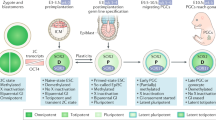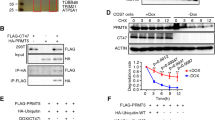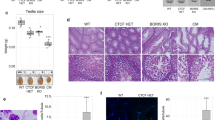Abstract
Chk2 is a transducer of DNA damage signals and a tumour suppressor whose germ-line mutations predispose to diverse tumour types. Unlike its downstream targets such as the p53 tumour suppressor, the expression patterns of Chk2 in tissues and tumours remain unknown. As DNA breaks occur commonly during gametogenesis, and p53 is wild-type and overexpressed in testicular cancer, we examined abundance and localisation of the Chk2 protein during normal development of human testes, and at various stages of germ-cell tumour (GCT) pathogenesis. Our results show that Chk2 is abundant in foetal germ cells and adult spermatogonia, yet only weakly expressed or lacking during the meiotic and later stages of spermatogenesis. High levels of Chk2 are detected in the majority of GCTs including all pre-invasive carcinoma-in-situ lesions, contrary to variable expression and even lack of Chk2 in subsets of invasive GCTs and some teratoma structures, respectively. Together with our analyses of cell culture models, these results indicate that downmodulation or lack of Chk2 is not simply attributable to quiescence or differentiation, they suggest a role for Chk2 in mitotic rather than meiotic divisions, support the concept of foetal origin of GCTs, and have implications for protein-based screening for tumour-associated aberrations of Chk2.
This is a preview of subscription content, access via your institution
Access options
Subscribe to this journal
Receive 50 print issues and online access
$259.00 per year
only $5.18 per issue
Buy this article
- Purchase on Springer Link
- Instant access to full article PDF
Prices may be subject to local taxes which are calculated during checkout



Similar content being viewed by others
References
Andrews PW . 1984 Dev. Biol. 103: 285–293
Barlow C, Liyanage M, Moens PB, Deng C-X, Ried T, Wynshaw-Boris A . 1997 Nat. Genet. 17: 462–466
Bartkova J, Bartek J, Lukas J, Vojtesek B, Staskova Z, Rejthar A, Kovarik J, Midgley CA, Lane DP . 1991 Int. J. Cancer 49: 196–202
Bartkova J, Thullberg M, Rajpert-De Meyts E, Skakkebæk NE, Bartek J . 2000a Oncogene 19: 4146–4150
Bartkova J, Thullberg M, Rajpert-De Meyts E, Skakkebæk NE, Bartek J . 2000b Int. J. Cancer 85: 370–375
Bell DW, Varley JM, Szydlo TE, Kang DH, Wahrer DC, Shannon KE, Lubratovich M, Verselis SJ, Isselbacher KJ, Fraumeni JF, Birch JM, Li FP, Garber JE, Haber DA . 1999 Science 286: 2528–2531
Chaganti RSK, Houldsworth J . 2000 Cancer Res 60: 1475–1482
Chehab NH, Malikzay A, Appel M, Halazonetis TD . 2000 Genes Dev. 14: 278–288
Cressman VL, Backlund DC, Avrutskaya AV, Leadon SA, Godfrey V, Koller BH . 1999 Mol Cell Biol 19: 7061–7075
Falck J, Mailand N, Syljuåsen RG, Bartek J, Lukas J . 2001 Nature 410: 842–847
Flaggs G, Plug AW, Dunks KM, Mundt KE, Ford JC, Quiggle MRE, Taylor EM, Westphal CH, Ashley T, Hoekstra MF, Carr AM . 1997 Curr. Biol. 7: 977–986
Grigor KM, Wylie CC . 1998 APMIS 106: 221–224
Hartley AL, Birch JM, Kelsey AM, Marsden HB, Harris M, Teare MD . 1989 Cancer Genet. Cytogenet 42: 221–226
Hirao A, Kong YY, Matsuoka S, Wakeham A, Ruland J, Yoshida H, Liu D, Elledge SJ, Mak TW . 2000 Science 287: 1824–1827
Kaneko YS, Watanabe N, Morisaki H, Akita H, Fujimoto A, Tominaga K, Terasawa M, Tachibana A, Ikeda K, Nakanishi M, Kaneko Y . 1999 Oncogene. 18: 3673–3681
Lee JS, Collins KM, Brown AL, Lee CH, Chung JH . 2000 Nature 404: 201–204
Lutzker SG, Levine AJ . 1996 Nat. Med. 2: 804–810
Mailand N, Falck J, Lukas C, Syljuåsen RG, Welcker M, Bartek J, Lukas J . 2000 Science 288: 1425–1429
Matsuoka S, Huang M, Elledge SJ . 1998 Science 282: 1893–1897
May P, May E . 1999 Oncogene 18: 7621–7636
Pleasure SJ, Lee VM-Y . 1993 J. Neurosci. Res. 35: 585–602
Rotman G, Shiloh Y . 1999 Oncogene 18: 6135–6144
Rotter V, Schwartz D, Almon E, Goldfinger N, Kapon A, Meshorer A, Donehower LA, Levine AJ . 1993 Proc. Natl. Acad. Sci. USA 90: 9075–9079
Schwartz D, Goldfinger N, Kam Z, Rotter V . 1999 Cell Growth Diff. 10: 665–675
Scully R, Livingston DM . 2000 Nature 408: 429–432
Shieh S-Y, Ahn J, Tamai K, Taya Y, Prives C . 2000 Genes. Dev. 14: 289–300
Skakkebæk NE, Berthelsen JG, Giwercman A, Müller J . 1987 Int. J. Androl. 10: 19–28
Vogelstein B, Lane D, Levine AJ . 2000 Nature 408: 307–310
Zhou BB, Elledge SJ . 2000 Nature 408: 433–439
Zickler D, Kleckner N . 1999 Annu. Rev. Genet. 33: 603–754
Acknowledgements
We thank P Andrews, S Elledge, G Evan and Maxwell Sehested for providing important reagents, and the Danish Cancer Society, the Nordic Cancer Union, the European Commission, and the Danish Medical Research Council for grant support.
Author information
Authors and Affiliations
Corresponding author
Rights and permissions
About this article
Cite this article
Bartkova, J., Falck, J., Rajpert-De Meyts, E. et al. Chk2 tumour suppressor protein in human spermatogenesis and testicular germ-cell tumours. Oncogene 20, 5897–5902 (2001). https://doi.org/10.1038/sj.onc.1204746
Received:
Revised:
Accepted:
Published:
Issue Date:
DOI: https://doi.org/10.1038/sj.onc.1204746
Keywords
This article is cited by
-
Role of HP1β during spermatogenesis and DNA replication
Chromosoma (2020)
-
The E3 ligase PIRH2 polyubiquitylates CHK2 and regulates its turnover
Cell Death & Differentiation (2013)
-
CHEK2 genomic and proteomic analyses reveal genetic inactivation or endogenous activation across the 60 cell lines of the US National Cancer Institute
Oncogene (2012)
-
Analysis of up-regulation of DNA-PKcs and its mechanism in human gliomas
Clinical Oncology and Cancer Research (2010)
-
Alterations of Chk1 and Chk2 expression in colon cancer
International Journal of Colorectal Disease (2008)



